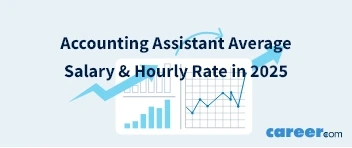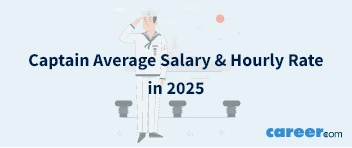How Much Does a HR Data Analyst Make? (2025)

An HR data analyst manages HR procedures for programs like benefits, salary, assessments, and training. They work with stakeholders on process design, project management, and HR initiatives. They improve operations and key functions such as onboarding, recruitment, terminations, and time management.
The Bureau of Labor Statistics (BLS) forecasts an 8% increase in employment for human resource specialists, including human resource analysts, from 2023 to 2033. Salary.com also reports the average salary of an HR data analyst in the United States is $65,300 per year.
Here are more details on HR data analyst salary trends, the highest-paying industries, career advancement prospects, and common questions about pursuing this job title.
Average HR Data Analyst Salary
The average base salary per year for HR data analysts in the United States is $65,300 as of February 20, 2025. In general, the salary range for an HR data analyst falls between $50,399 and $82,112, depending on factors such as location, experience, and skills.
2025 HR Data Analyst Salary: $65,300 per year ($31 per hour)
According to Salary.com, the average HR analyst salary per month is $5,442, equating to an average weekly compensation of $1,256. The average hourly wage for this position is approximately $31.
| Percentile | By Hour | By Week | By Month | By Year |
|---|---|---|---|---|
| 10th Percentile | $24 | $969 | $4,200 | $50,399 |
| 25th Percentile | $28 | $1,106 | $4,792 | $57,500 |
| 50th Percentile (Median) | $31 | $1,256 | $5,442 | $65,300 |
| 75th Percentile | $36 | $1,425 | $6,175 | $74,100 |
| 90th Percentile | $39 | $1,579 | $6,843 | $82,112 |
HR Data Analyst Salaries State by State
The income of HR data analysts might differ considerably by state, influenced by local economic conditions, cost of living, organizations presence, and demand for qualified employees. Experienced analysts generally receive greater compensation in states with a high cost of living and strong demand for specialized skills.
The District of Columbia ($72,600), California ($72,000), and New Jersey ($71,500) offer the highest pay for HR data analysts, but Mississippi has the lowest annual salary at $58,200.
As of February 2025, the following are the average annual wage for HR data analysts in various states in the United States, covering prominent industries.
| State | Average Salary |
|---|---|
| Alaska | $71,100 |
| Alabama | $60,000 |
| Arkansas | $59,500 |
| Arizona | $63,600 |
| California | $72,000 |
| Colorado | $66,600 |
| Connecticut | $70,100 |
| District of Columbia | $72,600 |
| Delaware | $66,200 |
| Florida | $62,000 |
| Georgia | $63,100 |
| Hawaii | $68,200 |
| Iowa | $62,500 |
| Idaho | $60,900 |
| Illinois | $66,800 |
| Indiana | $63,300 |
| Kansas | $62,100 |
| Kentucky | $61,400 |
| Louisiana | $62,100 |
| Massachusetts | $71,000 |
| Maryland | $67,300 |
| Maine | $63,500 |
| Michigan | $64,400 |
| Minnesota | $66,800 |
| Missouri | $62,200 |
| Mississippi | $58,200 |
| Montana | $61,000 |
| North Carolina | $62,600 |
| North Dakota | $64,600 |
| Nebraska | $61,500 |
| New Hampshire | $66,400 |
| New Jersey | $71,500 |
| New Mexico | $60,200 |
| Nevada | $65,500 |
| New York | $69,600 |
| Ohio | $63,800 |
| Oklahoma | $60,400 |
| Oregon | $66,300 |
| Pennsylvania | $65,100 |
| Rhode Island | $68,100 |
| South Carolina | $61,600 |
| South Dakota | $58,700 |
| Tennessee | $60,400 |
| Texas | $63,900 |
| Utah | $62,100 |
| Virginia | $65,500 |
| Vermont | $64,000 |
| Washington | $70,300 |
| Wisconsin | $64,500 |
| West Virginia | $58,700 |
| Wyoming | $62,600 |
What are the Best-Paying Cities for HR Data Analyst?
Similar to state-level variations, HR data analyst salaries can significantly differ by city, influenced by factors such as the cost of living, educational attainment, local demand, and the employment market.
Cities in California, including San Jose, San Francisco, and Oakland, provide some of the highest average yearly salaries for HR data analysts, rendering them appealing locations for professionals in this field.
| Cities | Average Annual Salary |
|---|---|
| San Jose, CA | $81,900 |
| San Francisco, CA | $81,600 |
| Oakland, CA | $79,600 |
| New York, NY | $76,200 |
| Queens Village, NY | $75,700 |
| Paramus, NJ | $75,200 |
How Experience Affects HR Data Analyst Salary?
The salary for HR data analysts increases with experience. According to the report, entry-level HR data analysts earn about $63,096 per year. After one to two years of experience, the income rises marginally to $63,960.
HR data analysts with 2 to 4 years of work experience normally make around $65,907, while senior HR analysts with 5 to 8 years of experience earn approximately $66,297. Professionals with more than 8 years of experience could get an average salary of $66,557.
| Levels | Salary |
|---|---|
| Entry-Level HR Data Analyst | $63,096 |
| Intermediate-Level HR Data Analyst | $63,960 |
| Senior-Level HR Data Analyst | $65,907 |
| Specialist-Level HR Data Analyst | $66,297 |
| Expert-Level HR Data Analyst | $66,557 |
How to Increase Salary as an HR Data Analyst?
For job seekers aiming to boost their salary as an HR data analyst, understanding the job description and key responsibilities within the HR department can provide a strategic advantage.
- Broaden Experience: Advancing from entry-level to senior roles increases salary potential. With more experience in employee relations and HR analytics, negotiating a higher salary becomes easier. Expert-level HR data analysts, for instance, anticipate an annual salary of about $66,557.
- Obtain Certifications: According to BLS, HR associations offer certifications such as SHRM-CP (SHRM Certified Professional) and SHRM-SCP (SHRM Senior Certified Professional). While voluntary, these credentials, especially for those with a business administration background, can demonstrate expertise and make candidates more competitive.
- Specialize in High-Demand Skills: Focus on well-compensated skills like vendor management, HR operations, and project evaluation. These specialized areas within the HR department typically command higher salaries.
- Work in High-Paying Regions: Salaries for HR data analysts vary by location. Relocating to cities with a higher cost of living and demand for skilled professionals, such as San Jose ($81,900) or San Francisco ($81,600), can significantly increase earning potential.
HR Data Analyst Skills
HR data analysts with specialized, in-demand skills have the potential to significantly increase their earnings. According to the Real-time Job Posting Salary Data Report, professionals with expertise in Project Evaluation can see a salary increase of 7.10%, while those skilled in Human Resource Operations may experience a salary boost of 6.97%.
Here are some key skills for HR data analysts and the potential salary increases that come with mastering them:
| Skill | Demand | Salary |
|---|---|---|
| Project Evaluation | 13.90% | 7.10% |
| Human Resource Operations | 30.13% | 6.97% |
| Vendor Management | 13.80% | 5.95% |
| Training Operations | 13.60% | 5.52% |
| Time-Off Programs | 13.30% | 5.52% |
| HR Data Analysis | 13.30% | 5.52% |
HR Data Analyst Salary FAQs
Here are some frequently asked questions (FAQs) about HR data analyst:
What does an HR data analyst do?
HR data analysts generally perform the following tasks:
- Facilitates the administration, deployment, and development of human resources processes.
- Manages the implementation of HR programs and coordinates with stakeholders to develop workflows.
- Assists in the implementation of HR initiatives, including training, performance management, benefits, and compensation.
- Optimizes HR operations by employing scalable methodologies.
- Facilitates the execution of fundamental HR procedures, such as onboarding, recruiting, dismissals retirements, and timekeeping.
- Guarantees the consistent and secure management of employee data in accordance with company policies and privacy regulations.
- Performs data analysis to deliver insights that enhance the effectiveness of HR decision-making.
- Prepares and submits the necessary HR reports and filings.
- Manages the coordination of contracts with HR outsourcing vendors.
What is the highest salary for HR data analysts?
Generally, experienced professionals with highly compensated skills or positions at bigger companies in highly demanded sectors are awarded the highest salary of an HR data analyst, which is estimated to be approximately $82,112.
What qualifications do I need to be a HR data analyst?
According to BLS, HR specialists, including HR data analysts, typically need a bachelor's degree in human resources, business, computer science or a related field. Internships provide hands-on experience and industry exposure. They also help build professional networks for future opportunities.



